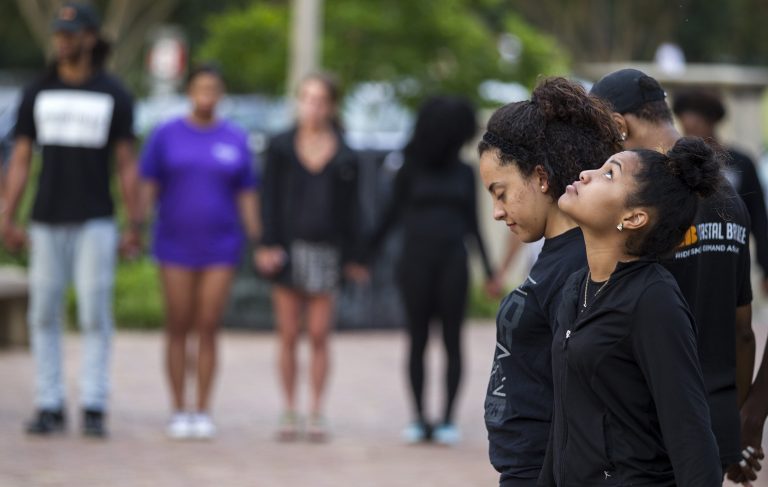
Image by Pixelfit/Getty Images, © All Rights Reserved.
What Do We Know of Genuine Apology and Deep Healing?
As I’ve borne witness to the #metoo movement these past few months, I’ve been wondering a lot about healing. This great wave of truth telling and accountability is rolling through a wide variety of industries, washing away years of stagnancy, corruption, and complicity. Abusers and harassers are being kicked out of their corner offices and restaurants and colleges. But where do they go? Surely the women and men that bravely joined together to shed a blinding light on their bosses’ cruelty get catharsis, but do they also get access to lost wages, to therapy, to space and time to heal? Do the men fallen from power learn how to live in the world differently? From whom?
We are inventing models of accountability, it seems, but we have yet to paint a picture of what healing — individually and collectively — looks like.
Certainly we believe these survivors of sexual harassment and abuse deserve to heal and are capable of it. But do we believe in the potential redemption of their harrassers and abusers? I suspect, as treacherous as that question feels coming from my fingertips on this keyboard, we are collectively starving for a yes. As much as we might pretend otherwise.
The deepest expression of our humanity depends on a belief in the possibility of redemption. For on some level, we all know that we are in need of redemption. We need to know that when it is our time to be called out, we won’t be thrown away, that people — maybe even our victims, most meaningfully our victims — will have faith in our capacity to change.
I’ve been thinking about our inability to heal when it comes to another vast and complex abuse of power: white supremacy. Just about every conference I go to, every long, lingering dinner among multiracial friends, features conversation about the reckoning we are living through regarding race and inequity. Thanks in large part to the Black Lives Matter movement, the festering wound of white supremacy has been made unprecedentedly visible to white people. No doubt, profound shifts have been made because of the growing awareness that racism is not over, and in fact is flowing through our own circulatory systems, a poison passed down from generation to generation. Black activists have risen up, networked together, and — along with some allies — rocked seismic shifts in the world’s surface.
And yet…and yet…as big as those tectonic shifts have been, I fear too much of the collective conversation has stayed at the surface. The wound begs for more than band-aids, diversity and inclusion trainings in our workplaces, anti-racism workshops in our schools, Black Lives Matter posters in our windows. Those things are all worthwhile, but this reckoning cannot be faced with strategy alone — and certainly not with performance. It begs for soul work. It begs for reparations. It begs for ritual.
And white people need to have a sense that we are collectively capable of redemption, or we get stuck in guilt or grow fragile or end up hiding or getting defeatist and giving up. We give up on the project of being accountable for our own actions — and, yes, even the actions of our ancestors — because we don’t really have faith in our capacity to heal the nation or ourselves. To change. To liberate ourselves from the lies that white culture tells about who we are, who we have been, and what we must be in order to succeed.
So my brothers, so my white people — what do we know of genuine apology and deep healing?
Very little, I’m afraid. We have so few models of this. Restorative justice is one, but it’s still so small-scale compared to the depth and breadth of our brokenness. It’s often focused on healing a particular crime, committed in a finite moment of time where the victim and perpetrator are obvious.
And for all of its promise, most of us haven’t been anywhere near one of these interactions. We know much more about creating simple stories about heroes and villains, media moments where someone apologizes (using the language, not of their own hearts) for being sexist or racist, and then waits for the headlines to fade (cue reinvention). But you can’t wait out these wounds.
We must strain for a more artful way, using a language that transcends generations, to actually acknowledge the pain that sexism and racism have caused. We need to tell our true history with slow reverence. We need to keep telling it over and over again. We need to make monuments to the resilience of the exploited and abused. We need to return to the earth, to our bodies, to the facts.
Next month, The Equal Justice Initiative will open the nation’s first memorial dedicated to lynching victims and a new museum dedicated to slavery in Montgomery, Alabama. The National Memorial for Peace and Justice, as it will be called, will recognize 4,000 people who were lynched and tortured in America. It includes soil samples from the sites where these humans were murdered, collected painstakingly by their descendants.
It is too late, but in another way, right on time. The sacred teacher we need so badly right now. How do we create more memorials — whether literal, like this one, or metaphorical — that allow us to acknowledge the depth of pain and offer some kind of way forward? This, it seems to me, is one of the questions of our time, and one we have to start asking out loud and in public.



Share your reflection